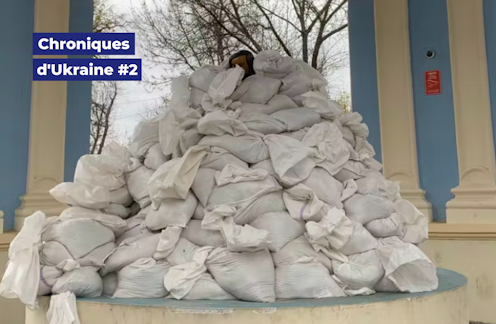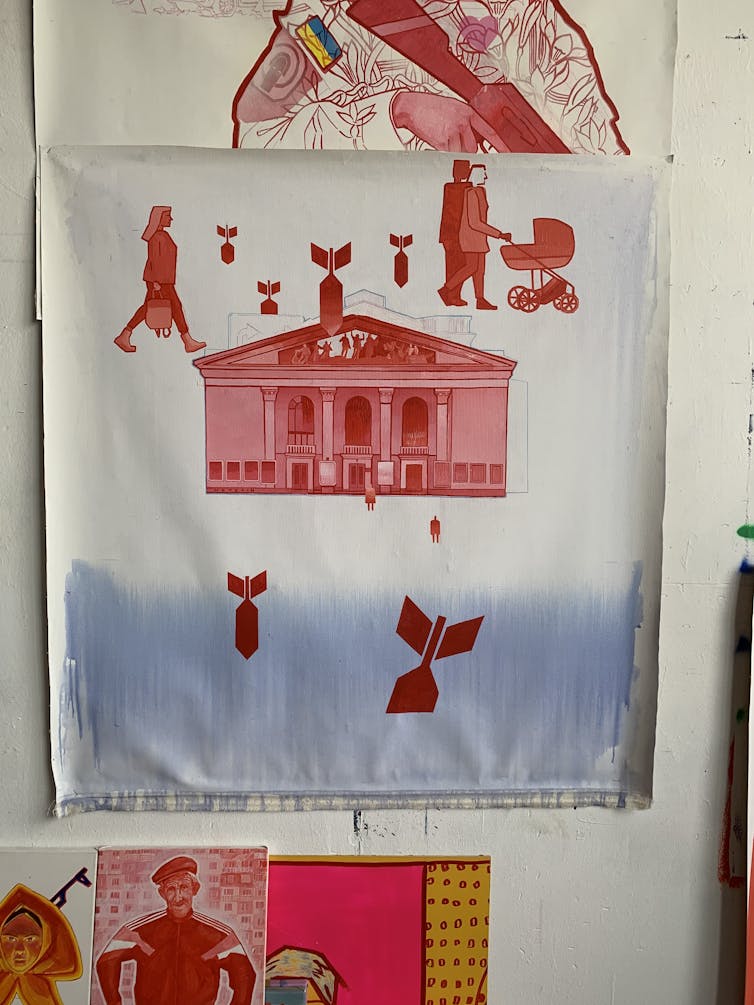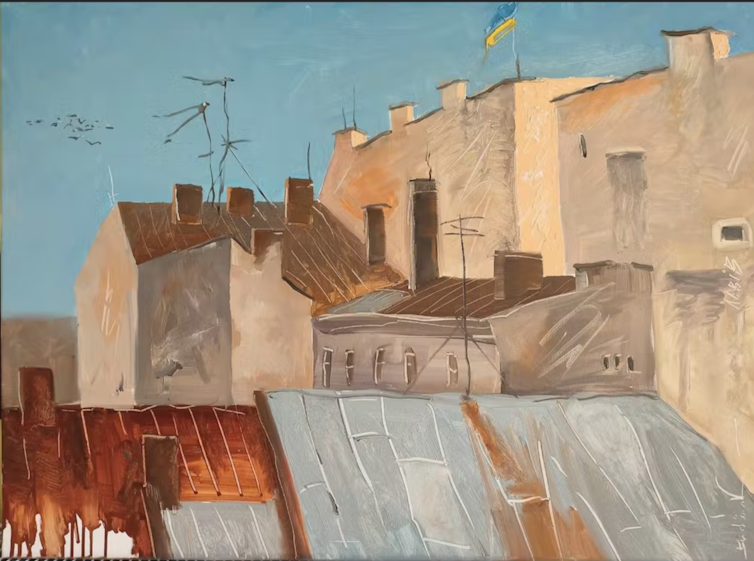
Lviv, 18–20 April 2022. The city is calm. The streets are full of onlookers, sauntering under the intermittent sunshine. At first glance, life looks normal. In reality, the changes are profound.
Since Russia invaded Ukraine, Lviv has welcomed tens of thousands of refugees from throughout the country, mainly from Kyiv and towns in the east. A curfew is in place from 10 p.m. to 5 a.m. The sale of alcohol has just been authorised again, but not before 8 p.m. Spirits are strictly forbidden. Around the city are several checkpoints, barricades built by civilian volunteers, minor protection on some windows, and sandbags or big tarpaulins protecting monuments from potential shrapnel. During my two days here, six or seven sirens have sounded around the city, disrupting collective life, but only momentarily. On 18 April, a Russian missile killed seven people.
The experience of war encourages people to focus their attention on armed resistance. But war also prompts nonviolent resistance. There is an everyday economy of war, woven from collective stitch-ups and arrangements. Behind the scenes, people replenish the frontline’s provisions, take in refugees, develop international networks and seek funding. This has to do with maintaining a peace economy in war time.
I wanted to meet artists and learn about their thoughts on resistance. Art provides a vital language to transcribe what is happening. War also rages within its boundaries as Ukrainians seek to confront Russian cultural dominance in post-soviet states.
Denys Metelin, a street artist
Denys Metelin, a street artist, is from Crimea. In 2014, after Russia’s invasion, his father packed his bags and threw him onto the next train to Lviv. He was 19. War has haunted him ever since.
He has made it the main subject of his work. His point of view is clear: he does not want to indulge in tragedy. To change how war is seen, “you need to find a perspective to understand the bombs”, he says. He plays and works with the symbols from the Soviet Union, subverting their meaning. His work strips war of its horrors and praises collective Ukrainian forces.



During the first two days of the invasion, Denys followed into the steps of thousands of Ukrainians by heading to one of the volunteering centres that sprang up throughout the city. He was clueless as to what to do.
“On the first day, I was so bewildered and panic-stricken that I went to buy sweets for child refugees and get a smile out of them. On the second day, we built barricades all over the city. On the third day, I learned how to make Molotov cocktails.”
Since then, he took first-aid lessons and also trained to fight. He stills attends these courses three times a week “to be ready if the Russians come here”.
Viktor Kudin, painting urban text
I also meet Viktor Kudin, an architect and artist. When the war broke out, he fled Kyiv for Lviv.

In addition to his work as an artist, Kudin raises funds for the Ukrainian army. He experienced Russia’s invasion as a real moral shock. Overwhelmed with stress and “negative feelings”, he went to buy material to paint with. Every day, you can find him on the rooftops of Lviv, painting the city, houses and streets.
His paintings show a somewhat transformed landscape. A detail attests to the ongoing war: graffiti insulting Putin, a small poster indicating the locations of shelters, plumes of black smoke drifting skywards, a Ukrainian flag holding out against the wind. People are absent from his paintings.
“When I paint, I will often hear the sirens before a blitz. I’m alone on the rooftops and the streets start emptying.”
War transforms life. It also has an impact on urban texts and cityscapes. Victor tells me his inspiration has taken a real hit. He wavers between “tears and hatred”, adding, “I can’t live with such intense feelings. I want to give names to these forces running through me. I want to understand them.”
Words get stuck in his throat. His anger frees them: “We’ve got to destroy Russia. We’re going to kill them all.”
Fear and fatalism
The artists I meet all come back to one consistent reaction: a combination of fear and fatalism. On 24 February 2022, it was disbelief that first took hold of them. Alexander Denysenko, an artist who shares a studio with his father, Oleh, confided to me:
“I was stunned. I didn’t know what to do. I left my house and started walking. I walked without knowing where I was going. I couldn’t stop walking. And then I phoned my friends. We wondered what we could do.”
This disbelief was all the more potent as many of these artists were a long way from the volunteer groups that have been operating in the Donbas since 2014. War was going on in the background, but it had been normalised. Its effects were not felt.
It has now broken into everyday life. In Lviv and elsewhere in Ukraine, it has become inescapable, even though it varies in intensity. Alexander’s disbelief quickly turned into a conviction that the Russian invasion was real. It was just that everything seemed submerged. Until then, he did not know anything about war as a tangible reality. But when war suddenly crashes down on you, life is abruptly transformed and, from then on, has to be organised alongside the war.
After their initial disbelief, and its share of disempowering feelings, their despondency turned into rebellion. The list of possible reactions to this kind of situation is limited: you can flee; you can try to maintain your habits in an upended and uncertain daily life; or you can make yourself useful without really knowing how. Some artists have taken up arms and gone to the front. Others have stayed put and continued to practise their art in spite of everything.
War provides opportunities: promoting Ukrainian art
These artists are determined to make Ukrainian art better known. Marta Trotsiuk runs a gallery. Before the war broke out, she would organise exhibitions throughout Lviv. She now works toward solidarity among the city’s artists to tackle the present emergency. She is energetic, even restless: she has been invited to take part in the Venice Biennale in the coming days. For her, this moment is an opportunity to make the uniqueness of Ukrainian art known.
Her first job was to organise a petition and a collective letter to denounce Russia’s aggression and call for sanctions against its artists. She justifies this by explaining that “culture is one of Moscow’s preferred methods in pushing its propaganda. It’s soft power, quite simply.”
In addition to this political initiative, Ukrainian artists are trying to organise a series of cultural events for refugees: concerts, plays, films, exhibitions – so many daily events that could help refugees “unwind”.
As the world collapses, art comforts people in the face of an unbearable reality. The purpose of these cultural events is not to directly express war or look at it differently. It is mainly to relieve people afflicted by war and forced in exile. Like others, Marta has set herself a challenge:
“[I want to make] people feel less inhibited about art, making our events attractive to them. We hope that they will come to think that there’s something for them in these events, and that our art will speak to them… People come from all over the country: from Kyiv, Odessa, and many other cities. They’re shy, they keep their distance, but when they come they’re always pleased to be there.”
“Being lumped together with the Soviet Union is simply unbearable.”
This claim that Ukrainian art is unique is especially heartfelt. Marta is disappointed and tired of people’s habits: like others, she bristles against the common confusion between Russian and Ukrainian art. She explains angrily:
“When we’re not being confused with Russians, we’re being portrayed as their ‘little brothers’… Being lumped together with the Soviet Union is simply unbearable. Our history is different. What’s more, our language is closer to Polish than it is to Russian. We’ve been independent since 1991. Since then, we’ve been fighting Russia’s imperialism and its daunting propaganda.”
Marta readily asserts how proud she is of Ukraine:
“I’m a proud Ukrainian. We have to carry on fighting. We even have to fight to get back our border from 1991, when we became independent. We have to change Russia’s government and get it to recognise what it’s carried out: genocide in Ukraine.”
This nationalistic line is unapologetic. The main tension in nationalism seems to reside in Marta’s words:
“We’ve got to be patriotic and keep our traditions alive, because we’ve been attacked. Otherwise, we’ll be wiped out as a people.”
National pride flourishes where a people is threatened with extinction. The war is giving the people the feeling they have discovered a collective power, a unity that is all the more strong as the threat is real. Behind Marta’s revolt, some prospects brought on by war are taking shape: the possibility of the world taking an interest in Ukrainian culture, artists, works and uniqueness. In a world crumbling, these artists have started dreaming of a new future: a people aware of itself, forging its destiny and promoting its uniqueness worldwide. The imagination is a place where reality can be defied.
Turning viewers into witnesses
Remarkably, art is not presented as it would be in peacetime. It does not seek to make war intelligible, or offer a break in which the world, in its cruelty, can find expression. Rather, it seeks to supplement war. It encourages uprising and a refusal to give up among all those who still have strength. Lastly, it records memory. All these works produced as the war rages capture the people’s accomplishments, actions and words, helping them escape transience. Artists hope to make us not just viewers but also witnesses.
And while some carry on creating works during the war, others try to salvage them. Bogdana Brylynska works at the “Territory of Terror” Memorial Museum in Lviv. From the outset of the war, she has been salvaging works throughout Ukraine, especially in the south and east of the country, where a large portion of Ukraine’s national cultural heritage can be found: “Our aim is to preserve heritage in Mariupol and so many other cities”, she says. Volunteers swing into action to protect monuments, using either tarps or sandbags, to protect them from shrapnel.

Some statues are hidden in secure locations – abroad or in underground passages. Volunteers also get organised to transport the most important works to Lviv. In all the country’s museums, people find creative ways to get works out:
“We’re not waiting for government orders to save these works. Since the Maidan Revolution, we’ve got used to getting organised on our own. Since then, we’ve forged so many ties with the whole country that we’re in touch with volunteers everywhere. Since the revolution, we’ve realised what our collective capacities are really like.”
Volunteers transport the artworks. This requires finding answers to practical questions, like how to pack up the works without damaging them:
“At first, we really didn’t know how to do it. We tried lots of methods before finding techniques that worked well enough… But that’s not the only problem. Because we don’t have any official licence to transport these artworks, there are tedious negotiations at checkpoints to establish that we’re not stealing the works but protecting them. You have to be resourceful. We’re used to it!”
In such a situation, resistance is about salvaging the materiality of the world, the memory of the country. It is about saving the world from destruction as much as you can. I’m now leaving Lviv to head for Kyiv, and then Kharkiv.
This article could not have been written without the precious help of Julia Sinkevych, a film producer. I am indebted to her for making my many meetings in Lviv possible.
Translated from the French by Thomas Young for Fast ForWord.
This article is a continuation of the author's research and ANR 'Ethnographie des guerillas et des émeutes: formations subjectives, émotions et expérience sensible de la violence en train de fait - EGR' https://anr.fr/Projet-ANR-18-CE39-0011.
This article was originally published on The Conversation. Read the original article.







